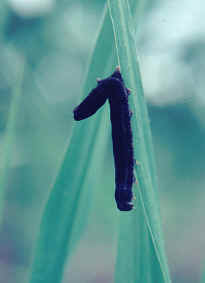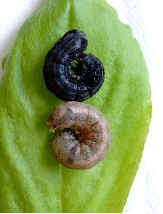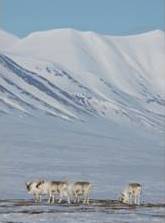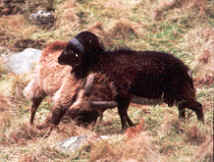Ecology of the African armyworm baculovirus (funded by BBSRC and DFID) African armyworm (Spodoptera exempta) is an economically-important crop pest in eastern Africa, especially Tanzania and Kenya. The caterpillars of this moth species Personnel: Dr Rob Graham, Yamini Tummala, Phill Nott |
 |
Role of Juvenile Hormone in density-dependent prophylaxis (funded NERC) As population density increases, so the risk of becoming infected by pathogens generally increases. As an evolutionary response to this, many insects have evolved a phenomenon known as density-dependent prophylaxis (DDP) - as population density increases, so the insects invest more in disease resistance mechanims and become lesss susceptible to infection. This NERC-funded study is examining the potential role of juvenile hormone in this phenomenon. Personnel: Shaihla Khan |
 |
|
Melanism and disease resistance in
insects (funded by NERC) |
 |
|
Nutrition
and disease resistance in insects (funded
by NERC/BBSRC) |
 |
|
Ecology
of gastrointestinal nematodes of Svalbard
reindeer (NERC) |
 |
|
Parasites
and the costs of resistance in Soay sheep
on St. Kilda (funded by NERC) |
 |
|
Testosterone
and mating behaviour of male Soay
sheep (funded by The Royal Society and Lancaster
University) |
 |
|
Sex-biased
parasitism and immunity in insects (funded
by NERC) |
 |
|
Bacterial Pathogens in Birds (funded
by NERC, BBSRC and CJ Wildfoods) Wild birds as potential vectors of disease have received recent renewed empirical interest, especially regarding human health. Understanding the spread of bacterial pathogens in wild birds may serve as a useful model for examining the spread of other disease organisms, both amongst birds, and from birds to other taxa. This project is developing molecular methods for monitoring bacterial pathogens found in birds. The longer term aim is to quantify the influence of bacterial pathogens on life history traits and reproductive success in wild birds. The project is in collaboration with Dr Ian R. Hartley ( Personnel: Clare Benskin, Rachel Hope. |
 |

Dr Rosa Menendez Research Interests (back to top)
|
Effects of climate change on the
structure of natural communities: a food web approach (funded by NERC)
Many butterflies in the Personnel: Annabel Rice |
 |
|
Identifying cost effective reforestation
approaches for biodiversity
conservation and carbon sequestration in the Australian wet tropics
(funded
by Australian Research Council). |
 |
Understanding the ways in which climate change could threaten northerly distributed species (funded by Climate change is predicted to become an important factor involved in species extinction and in particular mountain species and those restricted to high latitudes are the ones most likely to go extinct. The vulnerability of these species can be aggravated by other potential threats such as habitat loss and the arrival of other species from lowlands and low latitudes triggered by warming. This project studies the Northern Brown Argus butterfly (Aricia artaxerxes ) and its southerly sister species Brown argus (Aricia agestis) in Personnel: Dr. Rosa Menendez |
 |
Altitudinal changes in species distributions and their effect on total diversity: the influence of latitude and climate change (funded by NERC). Climate is a main determinant of species’ ranges, so global warming is expected to cause major changes in species distributions. Species ranges will contract at the warmer limit and expand at the cooler limit as a result of warming but few studies have investigated distributional shifts in the entire geographic range of a species. This project investigates changes in the altitudinal distribution of dung beetle species in six mountain regions along a latitudinal gradient across the whole of Personnel: Dr. Rosa Menendez |
 |
|
Species’ responses to climate change and their effects on community structure and ecosystem function (funded by NERC) This study is investigating the effects of current climate change on dung beetle communities, a group of insects which plays a crucial role in nutrient cycling in terrestrial ecosystems. The project examines changes in species and functional diversity as well as changes in the composition of communities by comparing data from 14 to 50 years ago with current data. The project also aims to predict how those changes in community attributes might affect ecosystem functions and services provided by dung beetles. The fieldwork is conducted in Europe (North and South England, French Alps and several areas in Personnel: Dr. Rosa Menendez |
 |
|
Understanding potential effects of climate change on dung beetle communities in subtropical rainforests (funded by This project investigates changes in dung beetle communities along an altitudinal gradient in subtropical rainforests. The aim of the project is to asses the sensitivity of different species to changes in temperature in order to identify potential bio-indicator species of climate change. The fieldwork is conducted in Personnel: Dr. Rosa Menendez |
 |

Dr Andy Wilby Research Interests (back to top)

